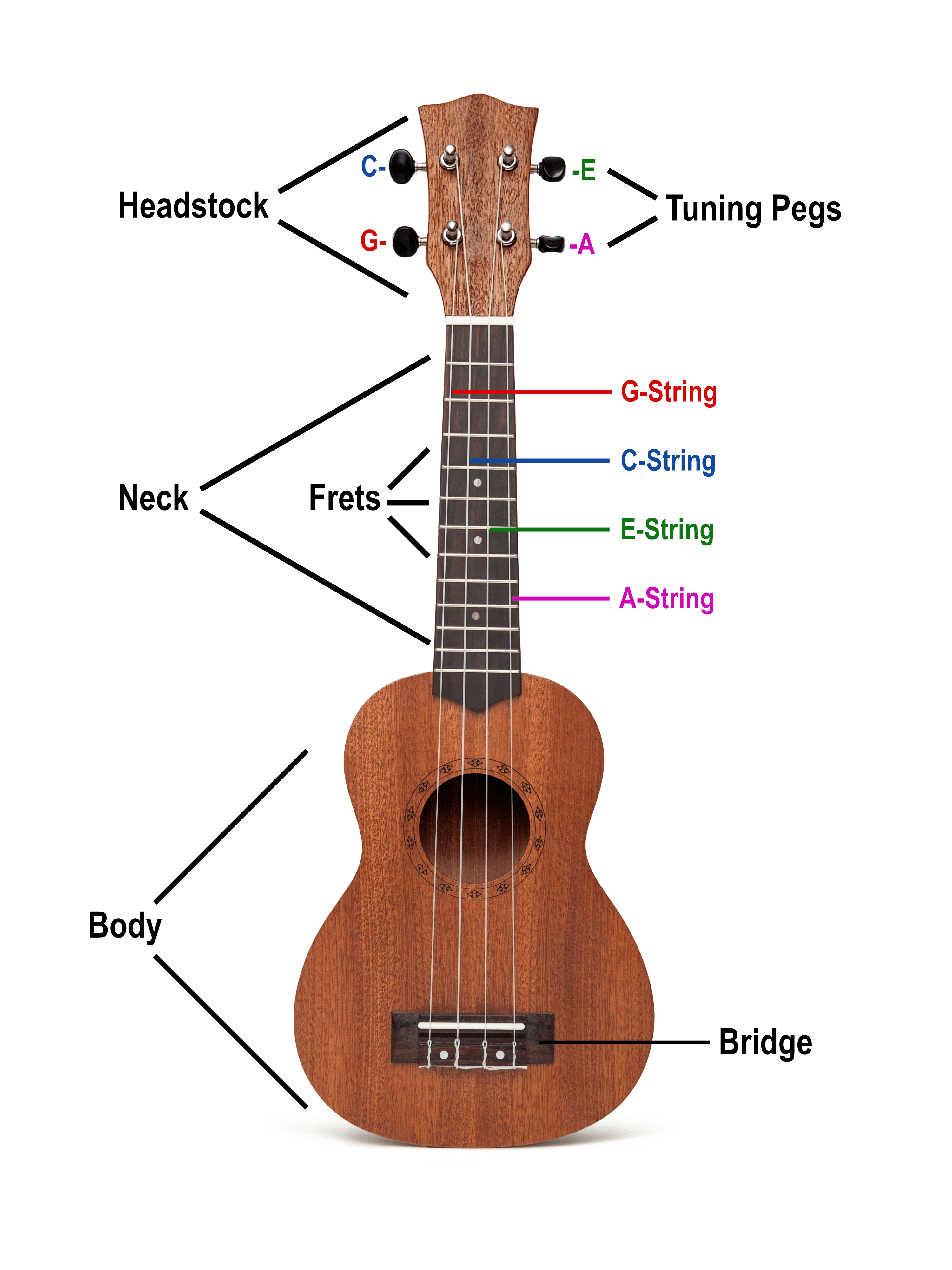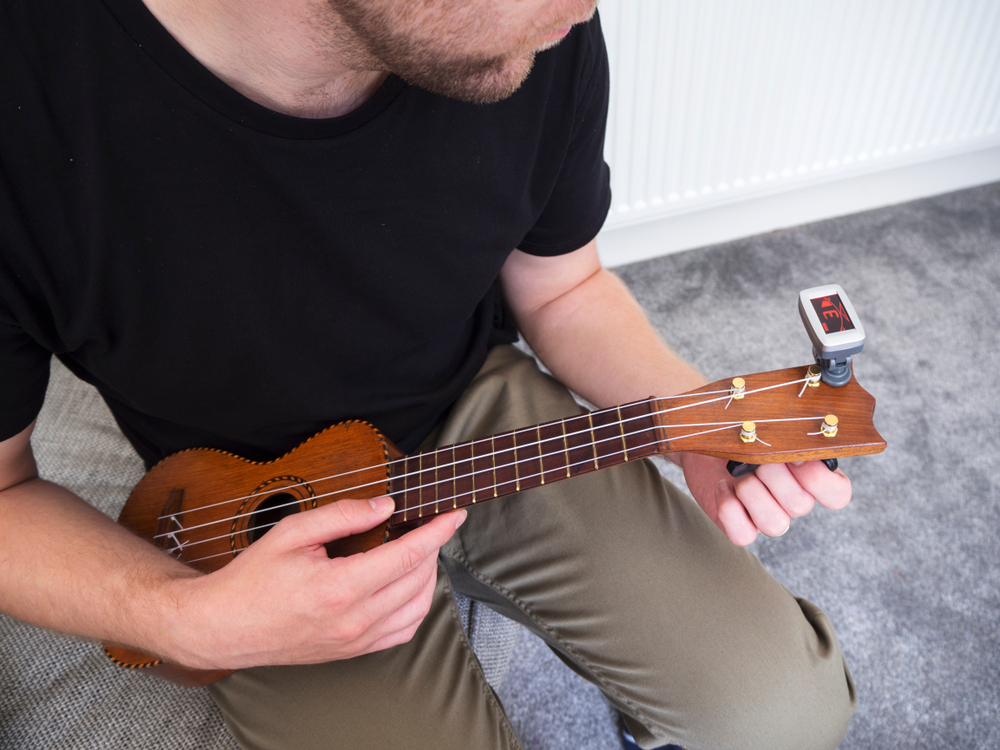When you learn to play a brand new instrument, you train your fingers, your mind, and your ears. If the instrument is out of tune, you won’t be able to tell if what you’re playing sounds right, and it’ll make singing along a lot less pleasant as well.
New ukuleles, especially starter ukuleles, are especially notorious for refusing to stay in tune. So any newcomer to the joyful instrument has to learn how to tune their ukulele by themselves. Thankfully, once you get the hang of it, tuning a uke is pretty easy.
This guide will set you on the path to tuning your ukulele correctly, with some basic terminology, a few different types of tunings, and a step-by-step guide on how to tighten your strings to change their pitch, along with all of the different accessories and techniques that’ll help you get each string in tune.
Parts of the Ukulele
In order to understand how to tune your ukulele correctly, it’s important that you know the names of its parts, as well as the correct tuning (note) of each individual string. As you go through this guide, you can refer back to the chart to help you visualize the process.

Uke Terminology to Get You Started
Here are a few other terms you’ll need to know before you can tune your ukulele for the first time.
Tuning
Tuning is both a noun and a verb. It can refer to the act of getting your ukulele in tune, or it can refer to the set of notes to which you’ll tune it: G, C, E, and A is the most common tuning.
Open Strings
An open string is a string that isn’t being pressed on. When you press on a fret, you change the note that the string will produce, while an open string will ring out in its true pitch. When you tune a ukulele, you’re effectively deciding what sound each string will make when it’s open.
Chord
A chord is a combination of notes played together. When you strum on two or more strings of your ukulele (that do not produce the same note), you play a chord.
Fretting
The frets are the little raised lines on the bridge of your neck. Pressing the string against a fret is called “fretting,” and it’ll change the note that the string produces.
Ukulele Tunings
There are a few different ways you can tune your ukulele, depending on what kind of sound you like, the type of ukulele you own, and what music you want to play. Standard tuning is by far the most common, so we’ll give it most of our attention throughout the rest of the article, but once you know about the other options, you’ll be able to apply our tips to any of the other tunings. The only thing that changes between tunings is the note of each open string.
Standard Ukulele Tuning: GCEA
Most ukuleles are tuned in standard tuning, so from top to bottom when you hold it in playing position, the strings are tuned to G, C, E, and A. Because of that, that’s also how we refer to the strings: G-string, C-string, E-string, and A-string. The three most common types of ukuleles, Soprano, Concert, and Tenor ukuleles all primarily use this standard tuning.
Notably, what makes standard ukulele tuning so different from guitar is that the G-string has the second-highest sound. Since it’s the first played string with a typical downward strum, it’s usually the first sound you’ll hear when playing a chord, and it’s responsible for the bright sound of the instrument. This nonlinear way in which the strings are organized makes standard tuning part of a category called re-entrant tuning.
Most of the ukulele song chords and tabs that you can find online are written with standard tuning in mind, although chords may also work for ukuleles tuned with a low-G.
Other Names for Standard Tuning
Standard tuning is sometimes written out as gCEA, which signals that the G-string is high. It’s also called C-tuning, high-G tuning, C6 tuning (which refers to the chord it produces when the open strings are played together), or ‘soprano’ tuning since it’s the most common way to tune a soprano ukulele.
What It Sounds Like: Youtube
Low-G Tuning
If you’d rather have your ukulele produce a richer sound that’s a bit more similar to a guitar, then you might prefer low-G tuning. For this kind of tuning, the G-string is tuned down an octave, so it’s the lowest string on the ukulele.
It sounds best on concert and tenor ukuleles. It can work on a soprano ukulele, but you run the risk that the thicker low-G string will put too much pressure on the shorter neck.
Additionally, many experienced players might add that the darker sound goes against the spirit of the soprano ukulele, which, by virtue of being smaller, is meant to have a higher sound.
For this kind of tuning, you’ll need to buy a low-G string, which is quite a bit thicker, if your ukulele didn’t come with one. Aquila is one of the most highly-regarded ukulele string brands, so we highly recommend their low-G strings for concert or tenor ukuleles.
Other Names for Low-G Tuning
This tuning style is sometimes referred to as linear tuning or tenor tuning. It’s sometimes written out as GCEA tuning, in order to differentiate it from standard gCEA tuning.
What It Sounds Like: Youtube
D-Tuning: ADF#B
Like standard tuning, it’s also a type of re-entrant tuning, since the top string (the A-string) has the second-highest sound.
This tuning is exactly one tone higher than standard tuning. It produces a sweeter, slightly higher sound, and it can work well with songs in the key of D major. It works well with soprano or concert ukuleles, but theoretically, you could also put a tenor into D-tuning, using the same strings as you would for standard tuning.
D-tuning was common in the early decades of the 20th century. If you happen to stumble across an old songbook, the chords might be written for a uke in D-tuning.
Other Names for D-Tuning
D-tuning is also called full setup tuning or English tuning. Some teachers will call it D6 tuning since that’s the chord it produces when you strum the open strings.
What It Sounds Like: Youtube
Canadian Tuning
The linear version of D-tuning is often called Canadian tuning, and to achieve it, you can simply string your uke with a low-G string, and then tune it to A.
Other Names for Canadian Tuning
Because the ukulele scene is not very formal, sometimes things can get a little confusing. Some players use the term “Canadian” tuning interchangeably with re-entrant D-tuning, which is something to keep in mind as you read more about ukes.
What It Sounds Like: Youtube
Other Tunings
If you have a baritone or bass ukulele, you’ll usually tune them as follows:
- Baritone ukuleles are tuned to DGBE.
- Bass ukuleles are tuned to EADG.
Tightening Your Strings
No matter which tuning or tuning method you settle on, you need to first learn the basics: how do you actually tighten and loosen your ukulele strings to change the pitch each one produces?
Why Are New Strings so Loose?
New ukuleles always come with the strings incredibly loose, which means that they produce a much lower sound than is ideal. This is a simple protective measure, since tight, tuned strings will exert pressure on the neck and headstock of the ukulele, increasing its chances of breaking during transport.
Either way, right off the bat, you’ll need to tighten your strings. By tightening them, you will increase their pitch until you get them to the right note.
How to Tighten Your Ukulele Strings
With most ukuleles, if you hold the ukulele with the strings facing you, the G and C-strings will be on your left, attached to the two tuning pegs on that side, while the E and A-strings will be on the right, attached to the pegs on the right side of the headstock.
With most ukuleles, to tighten the two strings on the left, twist the pegs upwards, away from the bridge. To tighten the strings on the right, however, you’ll want to twist the pegs downwards, towards the bridge. To loosen the strings, turn the pegs in the opposite direction.
As you tighten the strings, if you pluck them, you’ll notice their sound getting higher and higher. With these basics out of the way, let’s actually get that ukulele in tune! Be careful not to overtighten as you could snap the string. For this preliminary step, tighten them to a point where they’re relatively taut, but not so much that they’re at risk of breaking.

Tuning a Ukulele With a Clip-On Tuner
A clip-on ukulele tuner is the most elegant tool for tuning your ukulele. It’s a little device fitted with an LED display that clamps on to the headstock. It shows you which note you’re playing and whether your string is precisely on pitch. Some ukuleles come with a tuner, but if yours doesn’t, we recommend the GOGO Tiki Tuner from Sam Ash.
Getting Started
To use a clip-on tuner, you must first attach it to the headstock of the ukulele, right next to the tuning pegs. Next, turn it on by pressing the power button.
Choosing the Setting
You might have a few different tuning options, from chromatic (meaning that it’ll simply show you what note you’re playing) to options specifically for ukulele (which means that it’ll guide you specifically towards playing a specific ukulele tuning).
Most experienced players are just fine relying on the chromatic setting, but if you’re relatively new you might appreciate having it set to detect standard tuning.
Starting to Tune
Now is the fun part. If this is your first time tuning your ukulele, you’ll want to start tuning by playing an open string and slowly tightening the peg. Pay attention to the tuner display to see how close you’re getting to the right pitch.
Some players like to tune from the bottom-up, starting with the A-string, while others like to go top-down, starting with the G-string. That’s totally up to you, but going in a specific order is ideal because it’ll help to train your ear.
Ukulele Tuning Apps
In this day and age, we can use applications for nearly everything, and that includes tuning our ukulele. Tuning apps use your phone’s microphone to hear what sound your strings produce.
There are thousands of different tuning apps, but here are two that we recommend.
Ukulele Tuner
Ukulele Tuner is a simple, beginner-friendly ukulele tuner. It shows you which string is which as you tune, with multiple tuning options. It also includes a large chord library, which will come in handy as you learn to play. You can find it on both Android and iOs.
Guitar Tuna
GuitarTuna, from Yousician, is our favorite for those who play multiple instruments. It can help you tune your uke, guitar, bass and more, to just about any tuning. It’s available both on iOS and Android.
Tuning Apps vs. Clip-On Tuners
Tuning apps don’t have the same reliability or precision as a clip-on tuner. They can pick up all kinds of sounds from the environment, while a clip-on picks up the vibrations directly from your instrument, so it’s more precise.
The reliability of the tuning reliability heavily depends on the quality of your phone’s microphone, and it may also be compromised if you try to tune in a noisy environment. However, if you’re in a quiet space or you just don’t have your clip-on tuner on hand, they’re incredibly useful and are more than effective for most amateur players.
Relative Tuning
If you ever find yourself without a tuner or an app, learning relative tuning can be incredibly helpful. It’s called “relative tuning” because you tune your strings in relation to each other. It doesn’t guarantee that your strings will be tuned exactly to the correct notes, but it does guarantee that they’ll sound harmonious together.
- Tune your A-string first, to whatever pitch sounds right to you. You can also compare the sound to a friend’s instrument, an audio recording, or a tuning fork if you want it to be more precise.
- Next, press down on the 5th fret of your E-string, and tune it to sound just like your open A-string
- Then, press on the 4th fret of the C-string, and tune it to match the open E-string
- Finally, press on the 2nd fret of your G-string and tune it to match your open A-string
- If you have a low G-string, tune the 5th fret of the string to the open A-string, instead
Tuning a Ukulele by Ear
If you’re already very musical, you might feel confident enough to tune your ukulele by ear, with the help of a piano, a ukulele tuning video like the ones we linked to above, or even by solely relying on your own ability to recognize a note (although this requires advanced musical ability).
To do this, simply play the correct notes over and over again, compare the sound that your open strings make when you play them, and adjust the tightness of the strings accordingly.
How Often Should I Tune My Ukulele?
If you’re a beginner ukulele player, then you have an acronym to memorize: ABT, or Always Be Tuning. New ukuleles (or at least, ukuleles with new strings) fall out of tune incredibly quickly, sometimes even within minutes of tuning.
Since playing an out-of-tune ukulele is totally unacceptable, you should check the tuning of your ukulele consistently as you practice, so after every song or two.
After a few weeks of regular playing, your ukulele will not fall out of tune as quickly, so you’ll be able to check the tuning just once before you start playing, and you may even discover that you don’t have to fix it much if at all.

Play a Tune
Learning to tune your ukulele is an important step towards becoming a proficient player. It’ll make strumming away on your uke more pleasant for both yourself and others. There are a lot of tuning styles you can choose from, to suit your ukulele and the sound you prefer, as well as a lot of different methods that’ll help you find the right notes. So go forth, and make some music!
